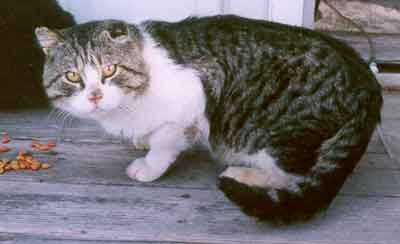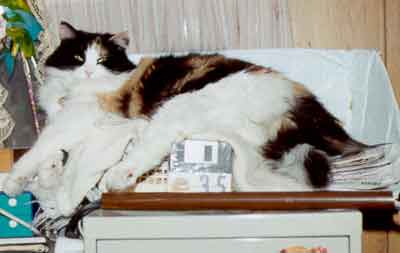PET HAPPENINGS - JUNE
2001
Pam Walston ~ Animal Lover At Large
by Carol N. Wells
Pam Walston has come to the aid of animals ever
since she can remember. Indeed, it seems she is one of the people
on this planet who’s destiny is that of doing animal humane
work of some kind throughout their entire lives.
 In
fact, when Pam was a little girl, she wanted to be a big, silver
horse. In ancient cultures, more than one legend speaks of the clairvoyance
of horses and their ability to recognize those involved with magic.
They are symbols that can express the side of humans. And so it
seems that Pam already knew at a young age, her magical abilities
to save and nurture hurt and/or unwanted animals that would continue
to cross her path.
In
fact, when Pam was a little girl, she wanted to be a big, silver
horse. In ancient cultures, more than one legend speaks of the clairvoyance
of horses and their ability to recognize those involved with magic.
They are symbols that can express the side of humans. And so it
seems that Pam already knew at a young age, her magical abilities
to save and nurture hurt and/or unwanted animals that would continue
to cross her path.
Pam successfully owned and operated Canyonlands Kennels until her
health mandated that she give up her kennel business.
Among the many animals that Pam has taken care of, a goat that was
leash trained is part of the list. Most of the pets Pam has kept,
are unadoptable and all have their own sad stories.
Take for instance, Sunny, an orange tabby who was part of a litter
being given away at City Market. When no one would take poor Sunny,
she was abandoned in the parking lot and wandered amid the noise,
heat, and confusion for three days before Pam ended up with her.
Pam states that, “I’ve never worked with an animal so
terrified. It took months of working with this eight-week old kitten
before she was able to respond in a somewhat normal fashion.”
Then there is Pounce dé Leon, who is a wonderful, long-haired
black and white tuxedo cat that I had the pleasure of watching perform
his many tricks. Yes, this cat does tricks on command. He begs,
waves goodbye, sits, lies down, turns in either direction on command,
and gives his right or left paw on command. Pounce got his name
because he did more pouncing than walking when he was a kitten.
Pounce was rescued from an abusive family situation. The father
was abusing the entire family and using Pounce as the object of
his powerplays.
Sally, Pam’s pure bred border collie, was one of a litter of
seven puppies who were abandoned with their mother in La Sal. The
owner, who was breeding border collies, decided to move, leaving
Sally, her mother, and littermates behind. By the time they were
found and caught, they had become “racks of bones.” Pam
helped place the puppies in good homes. Pam was hoping Sally would
also be adopted, but it seems she was meant for Pam. Since Pam knows
that the nature of a border collie is to have a job, Pam has trained
Sally to play several “games” during the day and to retrieve
whatever Pam might ask for. Whenever Pam says, “Beam me up,”
Sally will bring Pam the TV remote control. Sally will retrieve
2-liter pop bottles full of pop in case Pam is thirsty. And, Sally
knows how to play “hot” and “cold” to find items
in the house that Pam would like her to retrieve.
After working with all kinds of animals her whole life, Pam says,
“You can trust an animal to act like the animal it is; we’re
the ones who impose our own restrictions and unrealistic expectations
on them.”
 Since
Pam has nurtured so many dogs, cats, puppies, kittens, for placement
in homes and has always lived with both, I asked her if dogs were
easier to train than cats. Pam told me that, “Cats are just
as easy to train as dogs. Their motivation is also through food.
Cats have problems because they become bored. They need the equal
attention that dogs get. We have the assumption that because cats
act more independent, that they don’t need the same kind or
as much attention as we give our dogs. That is untrue. To train
a cat, I use a clicker to target the behavior I want to reinforce.
Clicker training works with dogs as well. The clicker becomes the
bridge between the behavior and the treat. You click exactly on
the behavior you want and immediately treat. So it becomes, click
and treat, click and treat. You have to make it seem like it’s
the cat’s idea. You can even train lions and tigers on clickers.”
Since
Pam has nurtured so many dogs, cats, puppies, kittens, for placement
in homes and has always lived with both, I asked her if dogs were
easier to train than cats. Pam told me that, “Cats are just
as easy to train as dogs. Their motivation is also through food.
Cats have problems because they become bored. They need the equal
attention that dogs get. We have the assumption that because cats
act more independent, that they don’t need the same kind or
as much attention as we give our dogs. That is untrue. To train
a cat, I use a clicker to target the behavior I want to reinforce.
Clicker training works with dogs as well. The clicker becomes the
bridge between the behavior and the treat. You click exactly on
the behavior you want and immediately treat. So it becomes, click
and treat, click and treat. You have to make it seem like it’s
the cat’s idea. You can even train lions and tigers on clickers.”
I asked Pam what she considered the main differences between cats
and dogs overall, “Cats have a better developed flight reflex,
and dogs have a better fight reflex, for one thing,” says Pam.
“Cats live in a colony and have a pecking order that can shift
around, whereas dogs live in a pack that has a rigid hierarchy.
In a pack, all the dogs look up to one alpha leader, then the beta,
and each dog knows his place in the pack. The leader must be challenged
and beaten if he is to take the alpha role. In a colony of cats,
there is a pecking order but it’s not as rigid. It’s more
like a benevolent dictatorship, having more to do with personalities,”
says Pam. “Also, cats come into heat several times a year and
will continue to come into heat until they have mated, whereas dogs
only come into heat twice a year, which accounts for the greater
numbers of cats needing homes than dogs,” says Pam.
As a whole, cats do better indoors, and when taken care of, can
live on the average of 15 years. Outdoor cats that are taken care
of only live on the average of 8 years, and feral cats only live
up to 5 year, according to the ASHS.
Since we were sitting in Pam’s yard during the interview, I
noticed several pinwheels in Pam’s garden. She told me that
she has found that the pinwheels keep the cats out of the garden,
and she has also tried moth balls and fresh orange peels with some
success.
Pam is, of course as you might guess, involved with the Humane Society
of Moab Valley, and volunteers her services as well as being a foster
home. Currently, Pam is nursing two young kittens who have lost
their mom and are too young to be adopted yet. We spoke of the importance
that a humane organization and how a successful one depends on a
ot of good volunteers, adequate funding and the fact that Moab’s
humane society could use more foster homes. As we discussed foster
care, Pam told me some of the depressing statistics about our animal
population across the country. Did you know that 3,000 animals per
minute are euthanized? If we emptied all the humane shelters and
“pounds,” each person in this country, and I repeat, each
person, would have to adopt 69 pets. Can’t afford to spay or
neuter your pet? 100 cans of pop or 25 packs of cigarettes will
equal the cost of a spay or neuter. I costs more to properly raise
four puppies than to have your dog spayed. The American Veterinary
Medical Association has done studies that show it is safe to spay
and neuter as early as six to eight weeks of age, and has also found
that this cut down on the chances of cancer, mammilary cancer and
pylometra (infection of the uterus). Knowing this information, makes
it difficult for anyone to have an excuse not to spay or neuter
their pet.
Pam and I spoke a long time about the overwhelming numbers of abandoned
animals, abuse, and also the uplifting stories that come from bonding
with a pet, indeed, volumes could be written on the subject. But
it is Pam’s hope and mine that as a culture we become more
responsible for the futures and well being of the animals we have
domesticated. I believe it was Niche who said, “You can determine
the advancement of a civilization by how it treats its animals.”
© 2001 Moab Happenings.
All rights reserved. Reproduction of information contained in this
site is expressly prohibited.